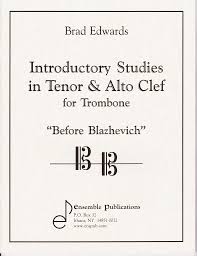Introductory Studies in Tenor & Alto Clef for Trombone "Before Blazhevich": A Review
 Introductory Studies in Tenor & Alto Clef for Trombone "Before Blazhevich" by Brad Edwards, Ensemble Publications, Ithaca, NY, 2002
Introductory Studies in Tenor & Alto Clef for Trombone "Before Blazhevich" by Brad Edwards, Ensemble Publications, Ithaca, NY, 2002
Many of us have done battle with the time honored Blazhevich Clef Studies either as a student, teacher or both. While Blazhevich's quirky etudes are excellent studies for teaching clef reading while solving varied musical problems, the typical complaints are that the first section (where studies are limited by an expanding number of positions) is too simplistic and the studies in all keys and positions are too difficult for younger students. Introductory Studies in Tenor & Alto Clef for Trombone "Before Blazhevich" by Brad Edwards is intended to bridge the gap in the clef study literature between the overly simplistic and the overly difficult and to provide an improved introductory experience to the second section of the Blazhevich Clef Studies.
Published in 2002 by Ensemble Publications, Introductory Studies is a well thought out text that features excellent printing and an affordable price of $15. The 112 etudes are divided into two sections Tenor Clef and Alto Clef with an introduction to clefs using Edward's concept of "Guidepost" notes. There are also short sections on reading Treble Clef Bb in Tenor Clef, Tenor Clef one octave down and a final set of etudes in three clefs. The etudes are mostly one half page in length and are varied by key, mode and difficulty.
Instead of Blazhevich's approach of studies in all clefs limited by positions, Introductory Studies uses "Guidepost" notes to help the student transfer his or her skills reading bass clef to tenor and alto clef. The staff and ledger lines D, F, C and E in Bass Clef are linked to the corresponding staff lines in tenor clef. Similar to the modern concept of teaching people to read by using "sight words," the student is given a chance to drill the "Guidepost" notes by the first 13 studies which are limited to notes that fall on "Guidepost" lines. This smart introduction is enhanced by the incorporation of varying keys, meters and rhythms.
After the introduction of "Guideposts" the etudes get gradually more involved with the introduction of melodies with five notes ranges, leaps of increasing size, the lower register and finally shifting between bass and tenor clef. The second section on Alto Clef reading follows the same layout beginning with "Guideposts" followed by progressive studies in Alto Clef culminating in a section using three clefs.
The pace of the exercises is just right and the length and difficulty of the studies are such that the student should be able to succeed in mastering one or two studies in a week. The etudes themselves are very musical and enjoyable to play without having that Blazhevich-like effect of consuming entire lessons. The rhythms and mix of scalar and leap-wise passages within each etude will keep the student "honest" in terms of reading what is on the page.
Mr. Edwards is to be congratulated on an excellent, well-conceived text that gives trombone teachers a better tool to teach clef reading.
